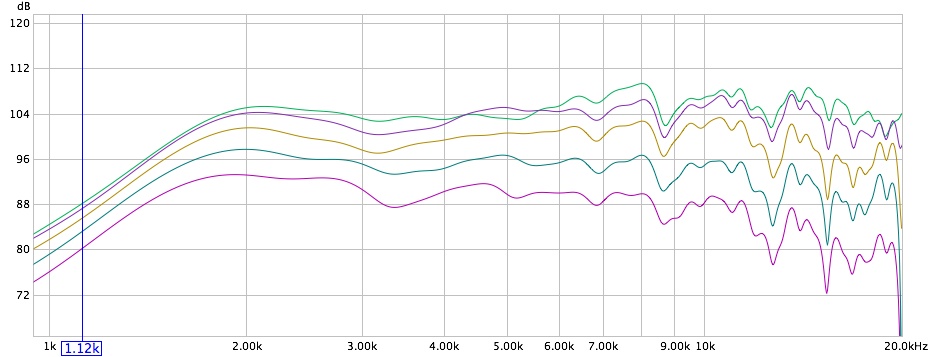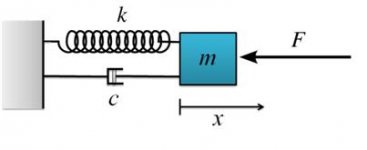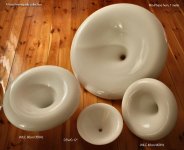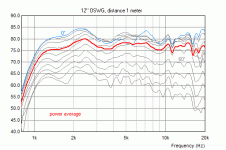This implies Earl must use a lot of corrections in crossover also because of crossing at woofer breakup. That's why I use 2" aluminum coil. But I still see above resonance as mostly electrical not acoustical.
I really do not think you are at the right track here - but its also not exactly my part to defend Earls contour and his design - anyway - you should check again your point of view (or setup possibly).
All data I've seen so far (and not only from Earl) indicates that OS works pretty well (if possibly not as heaven as advertised - but what does, I ask u ?)...
Michael
This implies Earl must use a lot of corrections in crossover also because of crossing at woofer breakup. That's why I use 2" aluminum coil. But I still see above resonance as mostly electrical not acoustical.
Minphase horn is far from being CD (especially in relation to size)- that's another story we need to solve.
All CD waveguides with compression drivers need at least two types of corrections due to the nature of the design. 1) there is a -6 dB / oct. fall because of CD - any system that does not exhibit this cannot possibly be CD, 2) there is a resonance of the compression driver - the diapragm resonance - and this will always cause a peak in the power response even if one is not evident on axis. These two features are 60% of my crossovers. There is a smaller resonance in the 12" and under waveguides due to the mouth reflection and an LRC helps to pull the power response of this down making for lower coloration. That's all that is usually done in my crossovers.
Some woofers do have breakups and these can be a problem, but I never operate a wofer in its breakup region, I just use a steeper crossover to filter out the resonances.
Nothing magic here, just good design.
...there is a -6 dB / oct. fall because of CD - any system that does not exhibit this cannot possibly be CD...
Well - I'd say - your interpretation on CD simply is wrong - I thought this we sorted out already...
Michael
BTW: Distance from phase plug to the first curvature is in my case ca. 25mm, quite short IMHO.
Well - I'd say - your interpretation on CD simply is wrong - I thought this we sorted out already...
Michael
Does it matter to this discussion?
Note that the reality is that Constant Directivity is whatever ElectroVoice claims it is. They trademarked it, and to the best of my knowledge still hold that trademark.
IMO the nomenclature is unimportant in this instance, rather the underlying filter needed for any waveguide's correction is what is being discussed. In Earl's case it's a 6db an octave highpass filter. Add to that filtration for the compression driver's resonance and perhaps some adjustment to net lowpass character of the Eq'ed waveguide and compression driver.
Of course if he used a compression driver with lower resonance, he might not even need any resonance correction for it.
Well - I'd say - your interpretation on CD simply is wrong - I thought this we sorted out already...
Michael
If you look at a flat piston in an infinite baffle, or mounted at the end of a long pipe (two cases for which analytical solutions exist), then if the response is flat on axis the directivity index increases with frequency, and asymptote to 6dB/octave as frequency rises. If you were to some how restrain the the directivity index to be constant then the on axis SPL would have to be the inverse of of that. It would start off constant and then decrease with an asymptote of -6dB/octave. No? A horn or wave guide is more complex that that simple example but would seem to have to have similar characteristics. Yes?
Don't know *how much* it matters – in the sense of trade mark(eting).
In the sense of what's possible or not in the technical meaning - and ones understanding of physics behind - I'd say it matters - and that's actually the "competition" here - no?.
So, if someone states that its not possible that we can have constant directivity (in the words technical meaning) *without* a 6dB slope – which is the case here – I hold against my measurements :
measurements taken without *any* EQ'ing at :
0 10 20 30 deg
http://www.diyaudio.com/forums/multi-way/159731-beautiful-swingin-speaker.html#post2060535

🙂
Michael
In the sense of what's possible or not in the technical meaning - and ones understanding of physics behind - I'd say it matters - and that's actually the "competition" here - no?.
So, if someone states that its not possible that we can have constant directivity (in the words technical meaning) *without* a 6dB slope – which is the case here – I hold against my measurements :
measurements taken without *any* EQ'ing at :
0 10 20 30 deg
http://www.diyaudio.com/forums/multi-way/159731-beautiful-swingin-speaker.html#post2060535

🙂
Michael
Last edited:
Don't know *how much* it matters – in the sense of trade mark(eting).
In the sense of what's possible or not in the technical meaning - and ones understanding of physics behind - I'd say it matters - and that's actually the "competition" here - no?.
So, if someone states that its not possible that we can have constant directivity (in the words technical meaning) *without* a 6dB slope – which is the case here – I hold against my measurements :
measurements taken without *any* EQ'ing at :
0 10 20 30 deg
http://www.diyaudio.com/forums/multi-way/159731-beautiful-swingin-speaker.html#post2060535

🙂
Michael
Oh-whoa, isn't that cute!
Attachments
Last edited:
Compare the power response with the SPL throughout the CD range in you sims. If the guide/horn is axisymmetric, then these should slopes should pretty much be in parallel.Well - I'd say - your interpretation on CD simply is wrong - I thought this we sorted out already...
Michael
It would start off constant and then decrease with an asymptote of -6dB/octave. No?
It should – yes – at a first glance....
As its so "intuitively", the mantra of this 6dB slope for CD – to my knowledge - has been repeated by all horn gods ever since it's been introduced by EV.
Until now – that a noob out of the middle of nowhere - known for "Sisi", Mozart-Kugeln or Swarovski gadgets at best - comes along with a dubious Gaussian MinPhase contour and proves otherwise.
Great fun to see the bible books of horn having to be rewritten (well, a chapter or two at least 🙂 )
LOL
Michael
Basically the assumptions are different from ATM type drivers. I don't think anything needs to be rewritten. Up to now, we have not seen measurements from the so called Gaussian MinPhase contour as someone originally promised.
Micheal, your measurements don't exactly show that your device is CD. An ordinary 1" dome tweeter has a response between 0 and 30 degrees off axis that looks better:
but it is certainly not CD.
An externally hosted image should be here but it was not working when we last tested it.
but it is certainly not CD.
we have not seen measurements from the so called Gaussian MinPhase contour as someone originally promised
Check:
http://www.diyaudio.com/forums/mult...man-diy-show-gelsenkirchen-6.html#post2075851
They will be updated - microphone (MBNM 550) had serious HF resonance.
Attachments
Up to now, we have not seen measurements from the so called Gaussian MinPhase contour as someone originally promised.
Micheal, your measurements don't exactly show that your device is CD... An ordinary 1" dome tweeter has a response between 0 and 30 degrees off axis that looks better:..
I don't argue you might get better results *under certain circumstances* with direct radiators.
What I do say though is that my horn contour *is* CD as CD can be - *without* having a 6dB slope.
To my knowledge CD is neither restricted to axisymmetric contours only (OS horns in the most spread form being more the exception than the rule here) nor is it said somewhere, how CD *exactly* has to look like.
So I'm confident that the measurements I've shown from my dipole horn with Gaussian MinPhase contour perfectly fit the term "CD horn".
Anybody is welcome to show measurements of horns here, that perform equally well in terms of directivity control, bandwidth, and lack for need of EQ'ing.
😉
Besides – if anybody wants to experiment or do his own measurements – it definitely does not cost an arm and a leg to check out yourself...
🙂
Michael
Last edited:
1/3 octave is too coarse. Nearly everything looks good in 1/3 octave. Can we see 1/24? How long is the impuls from which the frequency response was derived?
Best, Markus
Looked at those, although I'm not able to comment whether they are CD or not, but normally the SPL curves would be close together in a certain angle, then suddenly spaced obviously more widely out of the CD range. So personally, I would not call them CD.Check:
http://www.diyaudio.com/forums/mult...man-diy-show-gelsenkirchen-6.html#post2075851
They will be updated - microphone (MBNM 550) had serious HF resonance.
But I am curious, the higher frequencies look like some diffraction waves are effecting the results. The curves should normally not have those ripples even without smoothing if diffraction waves are very low. Seem like the source of diffraction is close to either the mic or the speaker.
I don't argue you might get better results *under certain circumstances* with direct radiators.
What I do say though is that my horn contour *is* CD as CD can be - *without* having a 6dB slope.
To my knowledge CD is neither restricted to axisymmetric contours only (OS horns in the most spread form being more the exception than the rule here) nor is it said somewhere, how CD *exactly* has to look like.
So I'm confident that the measurements I've shown from my dipole horn with Gaussian MinPhase contour perfectly fit the term "CD horn".
Anybody is welcome to show measurements of horns here, that perform equally well in terms of directivity control, bandwidth, and lack for need of EQ'ing.
😉
Besides – if anybody wants to experiment or do his own measurements – it definitely does not cost an arm and a leg to check out yourself...
🙂
Michael
I think a lot of this depends on what you accept as your definition of CD. My point was simply that measurements over a 30 degree spread don't show anything. A twit can build a speaker that has good polar response over a +/-30 degree horizontal and or vertical window. Not that I am a twit, but my NaO Mini has very uniform response over +/- 30 degrees below 10 k Hz to as low as the panel goes (100 Hz). You don't need horns or wave guides to do that, just proper choice of drivers and crossover points. The question is not that the response is constant over 30 degrees, but that when it starts to fall off, off axis, it falls off uniformly independent of frequency. That is, if at 60 degrees off axis it is down 8dB at 10 K Hz then it must also be down 8dB at 5K, 2,5k, 1k, 500, 250,.... if the speaker is truly CD. If not the directivity index will be a function of frequency.
If you look at the plots for Earl's Summa is appears to have pretty good CD behavior between 1k and 10K Hz out past 50 degrees. Further out the higher frequency starts to drop off faster, as would be expected. Below 1k hz it is obviously not CD but just reflects the directivity of the woofer. But the importance of the results are that there is no bulging of the response off axis in the region of the x-o. He has matched the directivity of the wave guided tweeter to that of the woofer. On the other hand, his Nathan is not so CD at all. But it may actually be the better speaker because although the directivity is a function of frequency, it would appear to be a very smooth function of frequency.
For a real world comparison, here I show my measurement of a "wash proof" CD horn – the ancient Electro Voice EV 350.
Compare and decide yourself if you think my Gaussian MinPhase contour performs at least as well in terms of CD and anything else for the range shown:
As we can see from a closer look at the 30d eg trace, the sound field defect (at ~6.5kHz) of conicals is pronounced here as well.
Mesasuremets at ~ 1m at 0 10 20 30 deg

Same as above but normalized to 0 deg :

And here is the spec sheet in case you are not familiar with that animal (which may possibly be unlikely for the most of you)
🙂
http://www.kinotechnik.edis.at/pages/diyaudio/BEM/EV_ST350/EV_ST350B.pdf
Besides that my contour clearly performs smoother, over a broader bandwidth and *without* any need for EQing the *parallelity* of my curves also is at least nothing worse then the EV sample .
*If* I'd go searching – think there would come up even worse – so called CD samples – no ?
😉
Michael
Compare and decide yourself if you think my Gaussian MinPhase contour performs at least as well in terms of CD and anything else for the range shown:
As we can see from a closer look at the 30d eg trace, the sound field defect (at ~6.5kHz) of conicals is pronounced here as well.
Mesasuremets at ~ 1m at 0 10 20 30 deg

Same as above but normalized to 0 deg :

And here is the spec sheet in case you are not familiar with that animal (which may possibly be unlikely for the most of you)
🙂
http://www.kinotechnik.edis.at/pages/diyaudio/BEM/EV_ST350/EV_ST350B.pdf
Besides that my contour clearly performs smoother, over a broader bandwidth and *without* any need for EQing the *parallelity* of my curves also is at least nothing worse then the EV sample .
*If* I'd go searching – think there would come up even worse – so called CD samples – no ?
😉
Michael
Last edited:
- Home
- Loudspeakers
- Multi-Way
- Geddes on Waveguides



